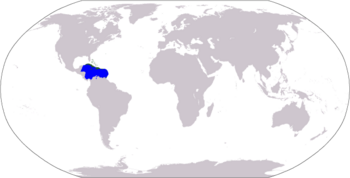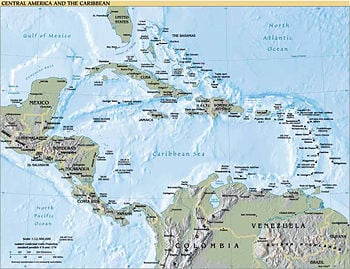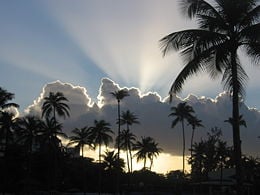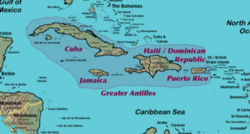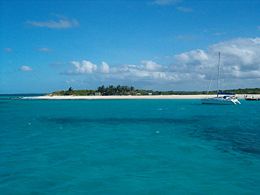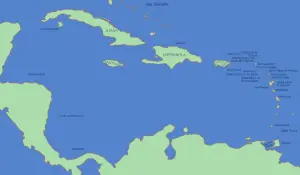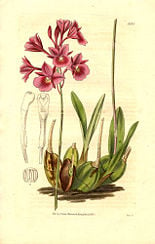Caribbean
The Caribbean (also known as the West Indies) is a region of the Americas consisting of the Caribbean Sea, its islands, and the surrounding coasts. The region is located southeast of North America, east of Central America, and to the northwest of South America. The islands of the Caribbean are sorted into three main island groups, The Bahamas, the Greater Antilles and the Lesser Antilles. Situated largely on the Caribbean Plate, the area comprises more than seven thousand islands, islets, reefs, and cays. Geopolitically, the West Indies is usually regarded as a sub-region of North America and is organized into 28 territories including sovereign states, overseas departments, and dependencies.
The Caribbean is a favorite destination for vacationers because of its beautiful beaches and tropical climate, as well as the exceptionally diverse ecosystems, ranging from montane cloud forests to cactus scrublands.
History reveals the significant role these islands played in the colonial struggles of the European powers between the sixteenth and nineteenth centuries, as well as in the twentieth century Cold War era. Most islands at some point were, or still are, colonies of European nations.
Caribbean vs. West Indies
The name "Caribbean" is named after the Caribs, one of the dominant Amerindian groups in the region at the time of European contact during the late fifteenth century.
The term "West Indies" originates from Christopher Columbus's idea that he had landed in the Indies (then meaning all of southeast Asia, particularly India) when he had actually reached the Americas.
The Spanish term Antillas was commonly assigned to the newly discovered lands; stemming from this, "Sea of the Antilles" is a common alternate name for the Caribbean Sea in various European languages.
In the English-speaking Caribbean, someone from the Caribbean is usually referred to as a "West Indian," although the rather cumbersome phrase "Caribbean person" is sometimes used. The use of the words "Caribbean" and "Caribbeans" to refer to a West Indian or West Indians is largely known in the English-speaking Caribbean.
Spanish-speaking Caribbeans do not like to be called Hispanics or Latins due to the significant differences between the South and Central American countries. Spanish-speaking Caribbeans not only have different native origins but they also have different histories, (Spanish) dialects, cultures, traditions, food, and moral and religious beliefs. They relate more easily to fellow Spanish-speaking Caribbean countries, specifically Puerto Rico, the Dominican Republic and Cuba due to similar culture, history and Spanish dialect.
Island Groupings
The islands of the Caribbean are sorted into three main island groups: The Bahamas, the Greater Antilles and the Lesser Antilles. The Greater Antilles consists of Cuba, Jamaica, the island of Hispaniola (composed of Haiti on the west side and the Dominican Republic on the east side) and Puerto Rico. The Lesser Antilles consists of all the other islands in the Caribbean that are not a part of the Bahamas, the Greater Antilles or an island belonging to a continental nation. The Lesser Antilles are further grouped into the Windward and Leeward Islands.
The Leeward Islands are the northern portion of the Lesser Antilles and consist of The Virgin Islands, Anguilla, St. Martin, Saba (Netherlands Antilles), St. Eustatius (Netherlands Antilles), St. Barthélemy, Antigua and Barbuda, St. Kitts and Nevis, Montserrat, Guadeloupe, and Dominica. The Windward Islands are the Southern portion of the Lesser Antilles and consist of Martinique, St. Lucia, St. Vincent and the Grenadines, Grenada, Barbados, and Trinidad and Tobago.
Geography and Climate
The geography and climate in the Caribbean region varies from one place to another. Some islands in the region have relatively flat terrain of non-volcanic origin. Such islands include Aruba, Barbados, Bonaire, the Cayman Islands, and Anguilla. Others possess rugged, towering mountain ranges like the islands of Cuba, the British Virgin Islands, Dominica, Hispaniola, Jamaica, Montserrat, Puerto Rico, Saba, St. Kitts, St. Lucia, Antigua, and Trinidad.
The climate of the region mainly ranges between sub-tropical to tropical and depends a great deal upon location in proximity to the tradewinds from the Atlantic. The Tradewinds blow towards the Eastern Caribbean Islands and head northwest up the chain of Windward Islands. There are no sharply marked changes between winter and summer in the West Indies. Average January temperatures range between 71°F to 77°F (22°C to 25°C), and average July temperatures range from 77°F to 84°F (25°C to 29°C). Climate can vary widely, especially on larger islands, where high mountains can give rise to variations from coastal weather patterns. The main difference between seasons is the amount of rainfall.
Hurricane season plays a large role in bringing rainfall to the Caribbean. However, on the larger islands the mountains have a strong effect on weather patterns and causes relief rainfall.
The Puerto Rico Trench located on the fringe of the Atlantic Ocean and Caribbean Sea just to the north of the island of Puerto Rico is said to be the deepest point in the entire Atlantic Ocean. In the waters of the Caribbean Sea, coral reef formations and large migratory schools of fish and turtles can be found.
Biodiversity
The Caribbean Islands support exceptionally diverse ecosystems, ranging from montane cloud forests to cactus scrublands. These ecosystems have been devastated by deforestation and human encroachment. The hotspot has dozens of highly threatened species, including two species of solenodon (giant shrews) and the Cuban crocodile. The hotspot is also remarkable for the diminutive nature of much of its fauna.
The Caribbean is home to 6,550 native plants, 41 native mammals, 163 native birds, 469 native reptiles, 170 native amphibians and 65 native freshwater fish. Many islands are home to their own species of native plants and animals, particularly Cuba, which is home to more than half the region's native plants.
History
The history of the Caribbean reveals the significant role the region played in the colonial struggles of the European powers between the sixteenth and nineteenth centuries. In the twentieth century the Caribbean was again important during World War II, in the decolonization wave in the post-war period, and in the tension between Communist Cuba and the United States. Genocide, slavery, immigration, and rivalry between world powers have given Caribbean history an impact disproportionate to the size of this small region.
The Caribbean Before European Contact
The oldest evidence of humans in the Caribbean is in southern Trinidad at Banwari Trace, where remains have been found from seven thousand years ago. These pre-ceramic sites, which belong to the Archaic (pre-ceramic) age, have been termed Ortoiroid. The earliest archaeological evidence of human settlement in Hispaniola dates to about 3600 B.C.E., but the reliability of these finds is questioned. Consistent dates of 3100 B.C.E. appear in Cuba. The earliest dates in the Lesser Antilles are from 2000 B.C.E. in Antigua. A lack of pre-ceramic sites in the Windward Islands and differences in technology suggest that these Archaic settlers may have Central American origins. Whether an Ortoiroid colonization of the islands took place is uncertain, but there is little evidence of one.
Between 400 B.C.E. and 200 B.C.E. the first ceramic-using agriculturalists, the Saladoid culture, entered Trinidad from South America. They expanded up the Orinoco River to Trinidad, and then spread rapidly up the islands of the Caribbean. Some time after 250 C.E. another group, the Barancoid, entered Trinidad. The Barancoid society collapsed along the Orinoco around 650 C.E. and another group, the Arauquinoid, expanded into these areas and up the Caribbean chain. Around 1300 C.E. a new group, the Mayoid, entered Trinidad and remained the dominant culture until Spanish settlement.
At the time of the European discovery of most of the islands of the Caribbean, three major Amerindian indigenous peoples lived on the islands: the Taíno in the Greater Antilles, the Bahamas and the Leeward Islands, the Island Caribs and Galibi in the Windward Islands, and the Ciboney in western Cuba. The Taínos are subdivided into Classic Taínos, who occupied Hispaniola and Puerto Rico, Western Taínos, who occupied Cuba, Jamaica, and the Bahamian archipelago, and the Eastern Taínos, who occupied the Leeward Islands. Trinidad was inhabited by both Carib speaking and Arawak-speaking groups.
The Colonial Era
Soon after Christopher Columbus came to the Caribbean, both Portuguese and Spanish explorers began claiming territories in Central and South America. These early colonies brought gold to Europe; most specifically England, the Netherlands, and France. These nations hoped to establish profitable colonies in the Caribbean. Colonial rivalries made the Caribbean a cockpit for European wars for centuries.
Spanish conquest
During the first voyage of the explorer Christopher Columbus (mandated by the Spanish crown), contact was made with the Lucayans in the Bahamas and the Taíno in Cuba and the northern coast of Hispaniola, and a few of the native people were taken back to Spain. Small amounts of gold were found in their personal ornaments and other objects such as masks and belts. The Spanish, who came seeking wealth, enslaved the native population and rapidly drove them to near-extinction. To supplement the Amerindian labor, the Spanish later began bringing African slaves to their colonies. Although Spain claimed the entire Caribbean, they settled only the larger islands of Hispaniola, Puerto Rico, Cuba, Jamaica, and Trinidad.
Other European Powers
After the Spanish Empire declined, in part due to the reduced native population of the area from diseases carried from Europe, to which the native peoples had no natural resistance, other European powers established a presence in the Caribbean.
- Francis Drake was an English privateer who attacked many Spanish ships and forts in the Caribbean, including San Juan harbor in 1595. His most celebrated Caribbean exploit was the capture of the Spanish Silver Train at Nombre de Dios in March 1573.
- The English admiral William Penn seized Jamaica in 1655, and it remained under British rule for over three hundred years. The British eventually also held Barbados, St. Kitts and Nevis, Antigua, Montserrat, and Bermuda.
- In 1697 the Spanish ceded the western third of Hispaniola (Haiti) to France. France also had control of Guadeloupe, Martinique, and Tortuga.
- The Dutch took over Saba, St. Martin, St. Eustatius, Curaçao, Bonaire, Aruba, Tobago, St. Croix, Tortola, Anegada, Virgin Gorda, Anguilla, and, for a short time, Puerto Rico, together called the Dutch West Indies, in the seventeenth century.
- The Danish ruled the present U.S. Virgin Islands from 1672 to 1917, selling sovereignty over these Danish West Indies to the United States in 1917.
- The Caribbean was known for pirates, especially between 1640 and 1680. The term "buccaneer" is often used to describe a pirate operating in this region.
Wars
The Caribbean region was war-torn throughout much of its colonial history, but the wars were often based in Europe, with only minor battles fought in the Caribbean. Some wars, however, were born of political turmoil in the Caribbean itself. The wars fought in the Caribbean included:
- The Thirty Years' War between the Netherlands and Spain.
- The First, Second, and Third Anglo-Dutch Wars.
- The Nine Years' War between the European powers.
- The War of Spanish Succession or Queen Anne's War, which spawned a generation of some of the most infamous pirates.
- The War of Jenkins' Ear or The War of Austrian Succession; Spain and Britain fought over trade rights; Britain invaded Spanish Florida and attacked the citadel of Cartagena de las Indias in present-day Colombia.
- The Seven Years' War or the French & Indian War, which was the first "world war" between France, her ally Spain, and Britain; France was defeated and was willing to give up all of Canada to keep a few highly profitable sugar-growing islands in the Caribbean. Britain seized Havana toward the end, and traded that single city for all of Florida at the Treaty of Paris in 1763.
- The American Revolution, which saw large British and French fleets battling in the Caribbean again. American independence was assured by French naval victories in the Caribbean.
- The French Revolution, which allowed for the creation of the Republic of Haiti.
- The Spanish-American War, which ended Spanish control of Cuba and Puerto Rico and heralded the period of American dominance of the islands.
Independence
Haiti, the former French colony of St. Domingue on Hispaniola, was the first Caribbean nation to gain independence from European powers when, in 1791, a slave rebellion of the Black Jacobins led by Toussaint l'Ouverture started the Haitian Revolution, establishing Haiti as a free, black republic by 1804. Haiti became the world's oldest black republic, and the second-oldest republic in the Western Hemisphere, after the United States. The remaining two-thirds of Hispaniola were conquered by Haitian forces in 1821. In 1844, the newly-formed Dominican Republic declared its independence from Haiti.
Some Caribbean nations gained independence from European powers in the nineteenth century. Some smaller states are still dependencies of European powers today. Cuba remained a Spanish colony until the Spanish American War.
Between 1958 and 1962 most of the British-controlled Caribbean became the West Indies Federation before they separated into many separate nations.
American Influence
Since the Monroe Doctrine, the United States gained a major influence on most Caribbean nations. In the early part of the twentieth century this influence was extended by participation in The Banana Wars. Areas outside British or French control became known in Europe as "America's tropical empire."
Victory in the Spanish-American War and the signing of the Platt Amendment in 1901 ensured that the United States would have the right to interfere in Cuban political and economic affairs, militarily if necessary. After the Cuban Revolution of 1959, relations deteriorated rapidly leading to the Bay of Pigs venture, the Cuban Missile Crisis, and successive U.S. attempts to destabilize the island, based upon Cold War fears of the Soviet threat. The U.S. invaded and occupied Hispaniola for 19 years (1915–1934), subsequently dominating the Haitian economy through aid and loan repayments. The U.S. invaded Haiti again in 1994 and in 2004 were accused by CARICOM of arranging a coup d'état to remove elected Haitian leader Jean-Bertrand Aristide.
In 1965 23,000 U.S. troops were sent to the Dominican Republic to quash a local uprising against military rule. President Lyndon Johnson had ordered the invasion to stem what he deemed to be a "Communist threat." However, the mission appeared ambiguous and was roundly condemned throughout the hemisphere as a return to gunboat diplomacy. In 1983 the U.S. invaded Grenada to remove populist left-wing leader Maurice Bishop. The U.S. maintains a naval military base in Cuba at Guantanamo Bay. The base is one of five unified commands whose "area of responsibility" is Latin America and the Caribbean. The command is headquartered in Miami, Florida.
Historical Groupings
Most islands at some point were, or still are, colonies of European nations:
- Spanish West Indies: Cuba, Hispaniola, Haiti until 1609, Puerto Rico, Jamaica until 1655, the Cayman Islands, Trinidad until 1797, and the Bay Islands until 1643.
- French West Indies: Anguilla, Antigua and Barbuda, Dominica, Dominican Republic, Grenada, Haiti, Montserrat, St. Lucia, St. Vincent and the Grenadines, St. Eustatius, St Kitts, Tobago, St. Croix, the current French overseas départements of Martinique and Guadeloupe (including Marie-Galante, La Désirade, and Les Saintes), and the current French overseas collectivities of St. Barthelemy and St. Martin.
- British West Indies/Anglophone Caribbean: Anguilla, Antigua and Barbuda, Bahamas, Barbados, Belize, the Bay Islands, the British Virgin Islands, the Cayman Islands, Dominica, Grenada, Guyana, Jamaica after 1655, Montserrat, St. Croix, Saint Kitts and Nevis, St. Lucia, St. Vincent and the Grenadines, Trinidad and Tobago after 1797, and the Turks and Caicos Islands.
- Danish West Indies: present-day United States Virgin Islands.
- Dutch West Indies: present-day Netherlands Antilles and Aruba, Virgin Islands, St. Croix, Tobago, and the Bay Islands.
- Swedish West Indies: present-day French St. Barthélemy.
- Portuguese West Indies: present-day Barbados, known as Los Barbados in the 1500s, when the Portuguese occupied the island during the same time as Brazil. However, the Portuguese abandoned Barbados in 1533, nearly a century prior to the British arrival on the island.
The British West Indies were formerly united by the United Kingdom into a West Indies Federation. The independent countries which were once a part of the British West Indies still have a unified composite cricket team that successfully competes in test matches and one-day internationals. The West Indian cricket team includes the South American nation of Guyana, the only former British colony on that continent.
In addition, these countries share the University of the West Indies as a regional entity. The university consists of three main campuses in Jamaica, Barbados, and Trinidad and Tobago, a smaller campus in the Bahamas, and resident tutors in other contributing territories.
The nations of Belize and Guyana, although on the mainland of Central America and South America respectively, are former British colonies and maintain many cultural ties to the Caribbean and are members of CARICOM (Caribbean Community). Guyana participates in West Indies cricket tournaments and many players from Guyana have been in the West Indies Test cricket team. The Turneffe Islands (and many other islands and reefs) are part of Belize and lie in the Caribbean Sea. The nation of Suriname, on the mainland of South America, is a former Dutch colony and also a member of CARICOM.
Indigenous Tribes
Regional Institutions
Some of the bodies that several islands share in collaboration include:
- Caribbean Community (CARICOM), Guyana
- Caribbean Examinations Council (CXC), Barbados and Jamaica
- Association of Caribbean States (ACS), Trinidad and Tobago
- Organization of Eastern Caribbean States (OECS), St. Lucia
- Caribbean Development Bank (CDB), Barbados
- Caribbean Disaster Emergency Response Agency (CDERA), Barbados
- Caribbean Program for Economic Competitiveness (CPEC), St. Lucia
- Caribbean Tourism Organization (CTO), Barbados
- Inter-American Economic Council (IAEC), Washington, D.C.
- United Nations - Economic Commission for Latin America and the Caribbean (ECLAC), Chile and Trinidad and Tobago
- Caribbean Association of Industry and Commerce (CAIC), Trinidad and Tobago
- Caribbean Association of National Telecommunication Organizations (CANTO), Trinidad and Tobago
- Caribbean Electric Utility Services Corporation (CARILEC), St. Lucia
- Caribbean Hotel Association (CHA), Puerto Rico
- Caribbean Regional Environmental Program (CREP), Barbados
- Caribbean Regional Fisheries Mechanism (CRFM), Belize
- Caribbean Telecommunications Union (CTU), Trinidad and Tobago
- West Indies Cricket Board (WICB), Antigua and Barbuda
ReferencesISBN links support NWE through referral fees
- Ferguson, James. Far From Paradise: An Introduction to Caribbean Development. London: Latin America Bureau (Research and Action). 1990. ISBN 0906156548
- Green, William A. British Slave Emancipation: The Sugar Colonies and the Great Experiment 1830–1865. Oxford: Clarendon. 1976. ISBN 0198224362
- Kurlansky, Mark. A Continent of Islands: Searching for the Caribbean Destiny. Reading, Mass: Addison-Wesley Pub. Co. 1992. ISBN 0201523965
- Rogoziński, Jan. A Brief History of the Caribbean: From the Arawak and the Carib to the Present. New York: Plume. 2000. ISBN 0452281938
- Rouse, Irving. Tainos: Rise and Decline of the People Who Greeted Columbus. Yale University. 1993. ISBN 0300056966
Credits
New World Encyclopedia writers and editors rewrote and completed the Wikipedia article in accordance with New World Encyclopedia standards. This article abides by terms of the Creative Commons CC-by-sa 3.0 License (CC-by-sa), which may be used and disseminated with proper attribution. Credit is due under the terms of this license that can reference both the New World Encyclopedia contributors and the selfless volunteer contributors of the Wikimedia Foundation. To cite this article click here for a list of acceptable citing formats.The history of earlier contributions by wikipedians is accessible to researchers here:
The history of this article since it was imported to New World Encyclopedia:
Note: Some restrictions may apply to use of individual images which are separately licensed.
